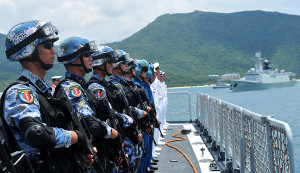
The RIMPAC exercises have been held once every two years since 1971 and during the Cold War, their main purpose was to train regional US allies for joint operations in the event of an armed conflict with the USSR or China. The official statements for the scenarios of several previous exercises carry a fairly neutral character. For example, according to the USPACOM website, the goal of RIMPAC 2014 is to “foster and sustain the cooperative relationships that are critical to ensuring the safety of sea lanes and security on the world’s oceans”.
However, even this Aesopian phrase hides one of the most important moments of the modern-day geopolitical game which is attributable to the comprehensive growth of China, whose foreign policy influence has increasingly expanded throughout the world’s oceans. Meanwhile, the development of naval forces has increasingly become a priority within China’s military expansion due to the country’s strategic, political and economic plans.
China’s naval forces ensure power projection (for now) in the critically important marine belt that lies between the Chinese shoreline and the so-called “First Island Chain”. The latter includes the Japanese-owned Ryukyu Archipelago, Taiwan, the Philippines and Indonesian Islands. This is also the space where tensions are mounting between China and Japan, Philippines, and Vietnam due to arguments of who owns several, mostly uninhabited, island archipelagos.
Many believe that the seabed under these islands hides large volumes of hydrocarbons. Moreover, ownership of these islands allows for the control of the last leg of the critically important marine trade routes that begin in the Persian Gulf and on Eastern African shores and pass through the Indian Ocean and the Strait of Malacca.
It is no accident then that the complex relationship between the two leading global players, that is, US and China, is beginning to see tensions flare when discussion touches on the space whose borders are drawn by these marine routes. However, that same marine space is seeing increasingly more involvement from India and Japan, two new regional players.
In this environment, the format of the current RIMPAC exercises with the participants who have gathered at Hawaii is fairly reminiscent of a dramatic scene from a detective novel. Generally speaking, the plot revolves around a group of people within an enclosed space, each of whom would have their own reasons to be accused of some wrongdoing.
These are the currently rising tensions in the Asia Pacific region which are significantly influenced by the “naval manoeuvring” conducted by each of the current RIMPAC participants over the previous few years. “Manoeuvring” here means the scale of construction, the strategies and the practices of using the national naval forces.
Especially intriguing for RIMPAC 2014 is China’s first participation in the exercises. The invitation to the event was handed to the former Chinese Defence Minister Liang Guanglie by his American colleague Leon Panetta during the latter’s official visit to Beijing in September of 2012.
In June of 2013, Beijing officially accepted the invitation to participate in RIMPAC 2014. Out of all of the guests invited by the American organisers to the current exercises, the Chinese navy is represented by the largest naval contingent. It includes a destroyer, a frigate, a logistics ship and a hospital ship.
It is also noteworthy that the abovementioned invitation extended to China came only a year after then State Secretary Hillary Clinton spoke about the “Asia pivot” within American foreign policy, which exhibited a clear anti-Chinese motivation. However, Barack Obama was getting ready for re-election for a second presidential term in the fall of 2012 and needed to demonstrate some positive tendencies in American foreign policy.
By this time, the American electorate began to show weariness towards the practically constant negativity within American foreign policy of the previous 15 years. Extending an invitation to its main geopolitical opponents to take part in multi-lateral naval exercises is a positive signal for the layman on the emergence of positive trends within the foreign policy of the next candidate for a new presidential term.
Due to the very fact that China is participating in RIMPAC 2014, American experts express cautious optimism towards the possible prospects of developing the entire system of bilateral relations and the situation that is emerging in the Asia Pacific region as a whole.
However, regional political games are far from being completely dominated by US-Chinese relations. They are instead increasingly influenced by the condition of the relations in the China, Japan and India triangle. The naval forces of the two latter countries are also participating in the exercises. One can only hope that these exercises and other multi-lateral events will aid in resolving the serious political problems in the Asia Pacific region.
Vladimir Terekhov, a Senior Research Fellow at the Center for Asia and Middle East of the Russian Institute of Strategic Studies, exclusively for the online magazine “New Eastern Outlook”.
